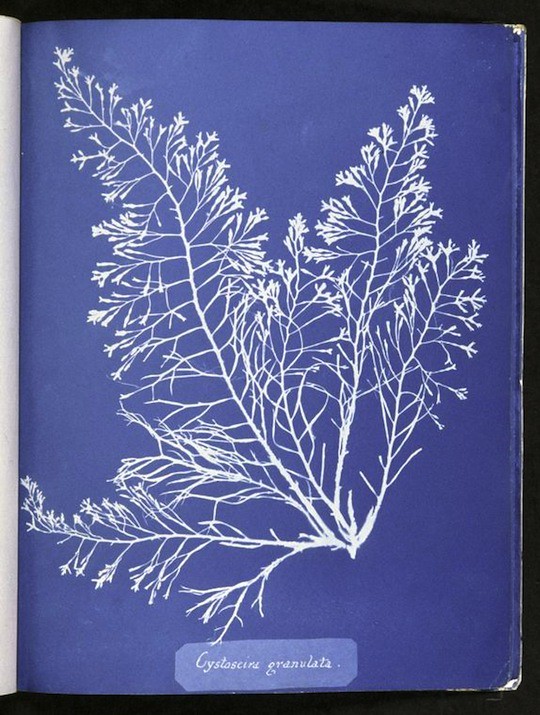Welcome to DU!
The truly grassroots left-of-center political community where regular people, not algorithms, drive the discussions and set the standards.
Join the community:
Create a free account
Support DU (and get rid of ads!):
Become a Star Member
Latest Breaking News
General Discussion
The DU Lounge
All Forums
Issue Forums
Culture Forums
Alliance Forums
Region Forums
Support Forums
Help & Search
Photography
Related: About this forumBlooming marvellous: the world's first female photographer and her botanical beauties

"Photography pioneer” conjures up an image of a Victorian gentleman under a drape with an outsize wooden box on a tripod. Yet one of the biggest landmark moments of early photography was down to a woman who didn’t even use a camera, and was born decades before Victoria became queen....
Atkins’s most important early influence was her father, John George Children. The two were particularly close, thrown together when Anna’s mother, Hester, died a few months after her only child’s birth. A highly respected scientist who was secretary of the Royal Society in 1826 and again between 1830-37, Children was unusual in his time for his belief that a daughter could do whatever a son could do, and he fostered her interest in botany.
But it was his contacts that helped his daughter the most. In February 1839 he was present at a Royal Society meeting at which a Wiltshire landowner, William Henry Fox Talbot, outlined his exciting new invention – the creation of “photograms”, that used chemicals and sunlight to create images on paper, and led to the development of camera-made images. Anna’s fascination with nature had seen her drawing shells and plants laboriously by hand to record them accurately; the implications of this new way of producing images were not lost on Children, who hurried home to share what he had heard. A few months later, Children wrote to Talbot that “my daughter and I shall set to work in good earnest ’till we completely succeed in practising your invaluable process”.
Anna – who had married a railway promoter called John Pelly Atkins in 1825 – was later influenced by another photography pioneer: Sir John Herschel. In 1842 Herschel sent Children a copy of his paper describing his refinement of Talbot’s process, an invention he called the cyanotype, involving two chemical compounds, ammonium ferric citrate and potassium ferricyanide, which were applied to a sheet of paper with a brush. The paper was dried, and a flat object was then laid on top of it, and left in sunlight. Once it had been exposed to enough light, the paper was washed in water, but the image of the object remained.
https://www.theguardian.com/artanddesign/2017/jun/23/blooming-marvellous-the-worlds-first-female-photographer-and-her-botanical-beauties
Atkins’s most important early influence was her father, John George Children. The two were particularly close, thrown together when Anna’s mother, Hester, died a few months after her only child’s birth. A highly respected scientist who was secretary of the Royal Society in 1826 and again between 1830-37, Children was unusual in his time for his belief that a daughter could do whatever a son could do, and he fostered her interest in botany.
But it was his contacts that helped his daughter the most. In February 1839 he was present at a Royal Society meeting at which a Wiltshire landowner, William Henry Fox Talbot, outlined his exciting new invention – the creation of “photograms”, that used chemicals and sunlight to create images on paper, and led to the development of camera-made images. Anna’s fascination with nature had seen her drawing shells and plants laboriously by hand to record them accurately; the implications of this new way of producing images were not lost on Children, who hurried home to share what he had heard. A few months later, Children wrote to Talbot that “my daughter and I shall set to work in good earnest ’till we completely succeed in practising your invaluable process”.
Anna – who had married a railway promoter called John Pelly Atkins in 1825 – was later influenced by another photography pioneer: Sir John Herschel. In 1842 Herschel sent Children a copy of his paper describing his refinement of Talbot’s process, an invention he called the cyanotype, involving two chemical compounds, ammonium ferric citrate and potassium ferricyanide, which were applied to a sheet of paper with a brush. The paper was dried, and a flat object was then laid on top of it, and left in sunlight. Once it had been exposed to enough light, the paper was washed in water, but the image of the object remained.
https://www.theguardian.com/artanddesign/2017/jun/23/blooming-marvellous-the-worlds-first-female-photographer-and-her-botanical-beauties
InfoView thread info, including edit history
TrashPut this thread in your Trash Can (My DU » Trash Can)
BookmarkAdd this thread to your Bookmarks (My DU » Bookmarks)
2 replies, 955 views
ShareGet links to this post and/or share on social media
AlertAlert this post for a rule violation
PowersThere are no powers you can use on this post
EditCannot edit other people's posts
ReplyReply to this post
EditCannot edit other people's posts
Rec (7)
ReplyReply to this post
2 replies
 = new reply since forum marked as read
Highlight:
NoneDon't highlight anything
5 newestHighlight 5 most recent replies
= new reply since forum marked as read
Highlight:
NoneDon't highlight anything
5 newestHighlight 5 most recent replies
Blooming marvellous: the world's first female photographer and her botanical beauties (Original Post)
mia
Oct 2017
OP
CaliforniaPeggy
(149,588 posts)1. How fascinating! Thank you for telling us about her and her father. n/t
alfredo
(60,071 posts)2. Id like to learn how to do that.